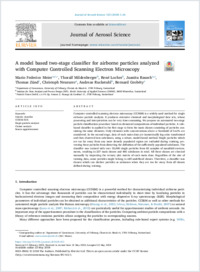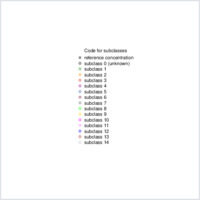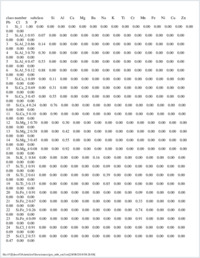A model based two-stage classifier for airborne particles analyzed with Computer Controlled Scanning Electron Microscopy
- Meier, Mario Federico Department of Geosciences, University of Fribourg, Switzerland - Particle Vision GmbH, c/o Fri Up, Fribourg, Switzerland
- Mildenberger, Thoralf Institute for Data Analysis and Process Design (IDP), Zürich University of Applied Sciences Winterthur, Switzerland
- Locher, René Institute for Data Analysis and Process Design (IDP), Zürich University of Applied Sciences Winterthur, Switzerland
- Rausch, Juanita Department of Geosciences, University of Fribourg, Switzerland - Particle Vision GmbH, c/o Fri Up, Fribourg, Switzerland
- Zünd, Thomas Particle Vision GmbH, c/o Fri Up, Fribourg, Switzerland
- Neururer, Christoph Department of Geosciences, University of Fribourg, Switzerland
- Ruckstuhl, Andreas Institute for Data Analysis and Process Design (IDP), Zürich University of Applied Sciences Winterthur, Switzerland
- Grobéty, Bernard Department of Geosciences, University of Fribourg, Switzerland
-
01.09.2018
Published in:
- Journal of Aerosol Science. - 2018, vol. 123, p. 1–16
English
Computer controlled scanning electron microscopy (CCSEM) is a widely-used method for single airborne particle analysis. It produces extensive chemical and morphological data sets, whose processing and interpretation can be very time consuming. We propose an automated two-stage particle classification procedure based on elemental compositions of individual particles. A rule-based classifier is applied in the first stage to form the main classes consisting of particles containing the same elements. Only elements with concentrations above a threshold of 5 wt% are considered. In the second stage, data of each main class are isometrically log-ratio transformed and then clustered into subclasses, using a robust, model-based method. Single particles which are too far away from any more densely populated region are excluded during training, preventing these particles from distorting the definition of the sufficiently populated subclasses. The classifier was trained with over 55,000 single particles from 83 samples of manifold environments, resulting in 227 main classes and 465 subclasses in total. All these classes are checked manually by inspecting the ternary plot matrix of each main class. Regardless of the size of training data, some particles might belong to still undefined classes. Therefore, a classifier was chosen which can declare particles as unknown when they are too far away from all classes defined during training.
- Faculty
- Faculté des sciences et de médecine
- Department
- Département de Géosciences
- Language
-
- English
- Classification
- Mineralogy
- License
-
License undefined
- Identifiers
-
- RERO DOC 322873
- DOI 10.1016/j.jaerosci.2018.05.012
- Persistent URL
- https://folia.unifr.ch/unifr/documents/307215
Other files
Statistics
Document views: 158
File downloads:
- pdf: 190
- Supplementary material: 147
- Tab 3: cluster centers: 131


